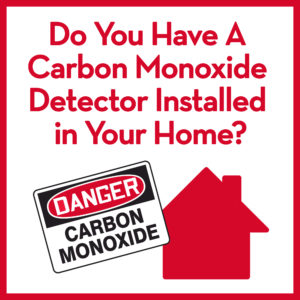Do You Have A Carbon Monoxide Detector Installed in Your Home?

Carbon monoxide is a colorless, odorless, tasteless gas produced by burning gas, wood, propane, charcoal or other fuel.
You must have a CO detector if you have fuel-burning appliances in your home. And if you have such appliances on more than one level of your home, you should have a carbon monoxide detector on each level. And it’s very important to install them near bedrooms too.
For a typical three-bedroom, two-bath home with an attic and basement, the National Fire Prevention Association (NFPA) recommends four CO detectors.
If something goes wrong with one of your fuel-burning appliances, such as your furnace, fireplace, stove or hot-water heater then dangerous levels of carbon monoxide can start to circulate throughout your home.
Here are the types of appliances/engines that can produce CO:
- Any oil, propane or natural gas furnace, cooking stove or range, refrigerator, hot water heater, other appliance or fireplace.
- Any wood or wood-burning product such as a woodstove, heat stove, fireplace, wood-pellet stove, box or parlor stove.
- A running car in an attached garage.
Check Your CO Detectors Today
Just like smoke detectors, you must monitor your CO detector to ensure it is in working order so it can protect you and your family when it’s most needed.
Remember to replace the device after 5-6 years. Check for a manufactured date stamped on the back to determine its age.
Look on the back of the CO detector for a UL symbol—for Underwriters Laboratories to ensure it has passed safety tests. This symbol indicates that it has been tested to a widely accepted safety standard. This is a third-party testing agency and lets you know that your device is certified. Unfortunately, there are some detectors out there that haven’t had third-party testing and have failed when exposed to dangerous levels of CO, according to Consumer Reports.
Don’t forget to replace batteries as needed. Set a time twice each year, like daylight savings, to replace your CO detectors’ batteries along with any smoke detectors in your home. Keep in mind that you also can buy CO detectors that are hard-wired or that can be plugged in.
State Requirements for Home Sellers and Homeowners
Many states have enacted legislation or imposed regulations that require home sellers to install carbon monoxide detectors before a home is sold. Some states also require home inspections by fire officials to make sure the devices have been installed correctly and are in working order before a home is sold.
Ask your realtor for the requirements for your specific state when you prepare to sell your home.
The Silent Killer
Carbon monoxide is poisonous to humans and pets so you need to take it seriously as a homeowner.
Mild exposure to CO can cause headaches, nausea, dizziness, irregular breathing, drowsiness and confusion. It has symptoms similar to the flu but without a fever. Those with heart disease can experience an increase in chest pain.
Severe exposure to CO can cause brain damage and death. Children and the elderly are even more susceptible.
CO doesn’t smell and you won’t be aware that high levels are being released into the air. That’s why it’s called the silent killer.
Some people who are overexposed simply fall asleep and never regain consciousness. Unfortunately, faulty heating devices are a major cause of CO poisoning during the cold weather.
If you think you or a family member has been exposed to CO, get outside immediately for fresh air and seek emergency medical help. Open the windows of your home to ventilate. Call the fire department and don’t use any faulty appliance/engine until it has been thoroughly checked out or replaced.
How to Prevent CO Poisoning
Improperly ventilated appliances and engines, particularly in a tightly sealed or enclosed space, may allow carbon monoxide to accumulate to dangerous levels.
That’s why it’s very important to have your appliances properly installed and maintained regularly. Have professional service inspections on a timely basis to ensure that your appliances and chimney are in working order and are venting properly. And, always follow manufacturer’s directions when operating any appliances. Other tips:
- Make sure the room where an unvented gas or kerosene space heater is used is well ventilated; doors leading to another room should be open to allow added ventilation.
- Never use an unvented combustion heater overnight or in a room where you are sleeping.
- Never use charcoal grills inside a home, tent, camper, or unventilated garage.
- Don’t leave vehicles running in an enclosed garage, even to “warm up” a car on a cold morning.
Be in touch if you have any questions about CO detectors. Take the time today to go through your home and look at each of you CO detectors and be sure you have one on every floor or consider getting additional devices.
Hi, there!
We're the Kurrle's and we love helping first time home buyers make their first home more affordable and stress-free! It all starts with your personal budget and how much you can comfortably afford. Let us know how I can help you make your real estate dreams come true.
Ready to Get Started?
Contact
443-504-7152
2200 Defense Hwy, Ste 400
Crofton, MD 21114
kurrleteam@firsthome.com
First Time Home Buyers
Apply Now
Home Owners
All Blog Posts
schedule your free consultation